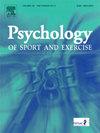心理-神经-内分泌相互作用对运动环境中动机气候的反应:一项实验调查
IF 3.1
2区 心理学
Q2 HOSPITALITY, LEISURE, SPORT & TOURISM
引用次数: 0
摘要
本实验研究的主要目的是评估前运动员在罚球训练期间对动机气候的心理神经内分泌反应。39名男性前篮球运动员(Mage = 20.18)被随机分配到一个罚球诊所,该诊所要么充满关怀,涉及任务的气候(CTIC;社会支持型,以掌握为中心)或自我参与的氛围(EIC;竞争剧烈,winning-centered)。在六个时间点收集唾液样本以评估唾液皮质醇、睾酮和α -淀粉酶,包括两个基线(从临床开始的- 45和- 30分钟)和四个响应/返回基线样本(t = + 20、35、50和65分钟)。参与者完成了门诊前和门诊后的调查,以评估心理社会压力经历、心理社会压力反应(如羞耻)、享受、认知和躯体焦虑以及自信。与CTIC参与者相比,EIC参与者的唾液皮质醇和睾酮浓度明显更高,并报告了更大的社会心理压力经历和羞耻感。EIC组参与者的唾液皮质醇、睾酮和α -淀粉酶水平与基线相比显著增加,同时睾酮/皮质醇比(T/C比)也显著增加。相比之下,CTIC参与者在罚球诊所报告了更大的享受,他们的唾液皮质醇水平相对于基线水平下降。总的来说,研究结果表明,当运动员沉浸在CTIC中而不是EIC中时,他们对表现压力的反应更有利。同样,EIC参与者的心理神经内分泌特征表明,在运动环境中反复暴露于EIC可能对运动表现和恢复有不利影响,尽管还需要进一步的研究。本文章由计算机程序翻译,如有差异,请以英文原文为准。
Psychoneuroendocrine interactions in response to the motivational climate in a sport setting: An experimental investigation
The primary purpose of this experimental investigation was to assess former athletes’ psychoneuroendocrine responses to the perceived motivational climate during a free throw shooting clinic. Thirty-nine male former basketball players (Mage = 20.18) were randomly assigned to a free throw shooting clinic with either a caring, task-involving climate (CTIC; socially supportive, mastery-focused) or an ego-involving climate (EIC; hypercompetitive, winning-centered). Saliva samples were collected at six time points to assess salivary cortisol, testosterone, and alpha-amylase including two baseline (t = −45 and −30 min from the start of the clinic) and four response/return-to-baseline samples (t = + 20, 35, 50, and 65 min). Participants completed pre- and post-clinic surveys in order to assess psychosocial stress experiences, psychosocial stress responses (e.g., shame), enjoyment, cognitive and somatic anxiety, and self-confidence. Compared with the CTIC participants, the EIC participants had significantly greater salivary cortisol and testosterone concentrations and reported greater psychosocial stress experiences and shame. The salivary cortisol, testosterone, and alpha-amylase levels of participants in the EIC group increased significantly from baseline, along with their testosterone/cortisol ratio (T/C ratio). In contrast, CTIC participants reported greater enjoyment during the free throw clinic and their salivary cortisol levels decreased relative to baseline levels. Collectively the findings suggest athletes respond more favorably to performance stress when immersed in a CTIC as opposed to an EIC. Likewise, the psychoneuroendocrine profile of the EIC participants indicate that recurrent exposure to EICs in sporting contexts may have adverse implications for athletic performance and recovery, although further research is needed.
求助全文
通过发布文献求助,成功后即可免费获取论文全文。
去求助
来源期刊
CiteScore
6.40
自引率
5.90%
发文量
172
审稿时长
69 days
期刊介绍:
Psychology of Sport and Exercise is an international forum for scholarly reports in the psychology of sport and exercise, broadly defined. The journal is open to the use of diverse methodological approaches. Manuscripts that will be considered for publication will present results from high quality empirical research, systematic reviews, meta-analyses, commentaries concerning already published PSE papers or topics of general interest for PSE readers, protocol papers for trials, and reports of professional practice (which will need to demonstrate academic rigour and go beyond mere description). The CONSORT guidelines consort-statement need to be followed for protocol papers for trials; authors should present a flow diagramme and attach with their cover letter the CONSORT checklist. For meta-analysis, the PRISMA prisma-statement guidelines should be followed; authors should present a flow diagramme and attach with their cover letter the PRISMA checklist. For systematic reviews it is recommended that the PRISMA guidelines are followed, although it is not compulsory. Authors interested in submitting replications of published studies need to contact the Editors-in-Chief before they start their replication. We are not interested in manuscripts that aim to test the psychometric properties of an existing scale from English to another language, unless new validation methods are used which address previously unanswered research questions.

 求助内容:
求助内容: 应助结果提醒方式:
应助结果提醒方式:


